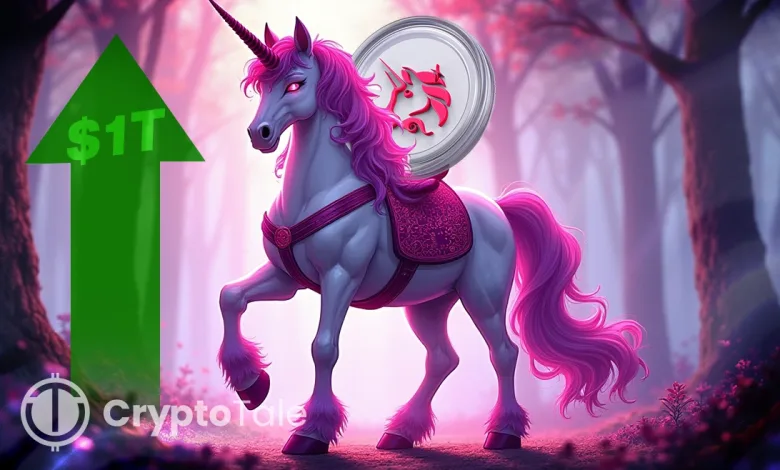Uniswap Crosses $1T Annual Volume as Q3 2025 Nears $300B

- Uniswap surpassed $1 trillion in yearly volume as Q3 2025 trading exceeded $270B.
- The UNI token slipped 5.43 percent despite a stronger platform trading performance.
- Data indicated that Uniswap reclaimed 35.9 percent of the DEX market share.
Uniswap has achieved a historic milestone of $1 trillion in its annual volume and has also exceeded its trading volume in Q3 2025. According to data from Token Terminal, the decentralized exchange has surpassed $270 billion in the 3rd quarter, with more than a week still left in the quarter, putting it on its for its strongest quarter ever. Data from the chart shows consistent growth since early 2024, when Q1 2025 volumes already crossed $200 billion.
The same data confirms Q3 2025 is nearing the $300 billion mark, breaking well above the previous peak from late 2021. At that time, trading volumes briefly surpassed $200 billion, but Uniswap’s latest performance has moved significantly higher. An analyst posting the data remarked, “Q3’25 will be a record month for @Uniswap in terms of quarterly trading volume.”
CEO Hayden Adams also confirmed the broader annual picture. Posting on X, Adams revealed Uniswap’s annual trading volumes have topped $1 trillion for the first time in its history. He said, “Meanwhile, volumes are at an all-time high, exceeding $1T/year for the first time. The reg env massively improved. And many exciting things on the horizon :).”
Uniswap Expanding Its Market Share
Independent data aligns with these announcements. A September report from CoinGecko estimated that Uniswap captured 35.9% of total decentralized exchange trading in August 2025. This equated to $111.8 billion in processed volume for the month, an increase of 28.3% compared with July.
Other industry sources covered Uniswap’s August leadership, making it apparent that the exchange has stayed competitive despite the presence of many competitors in the DEX market. The increase in monthly growth and larger market share indicate that volumes are being propelled by a wide base of user activity rather than isolated spikes.
In addition to the development of trading, product adoption also adds to Uniswap’s throughput. Studies conducted by 21Shares reported a high adoption of Uniswap v4 in mid-2025. Towards the end of July, over 100 billion in cumulative trading volume had already been executed via v4, and over 1 billion in total value locked had been secured. The reduced transaction costs on Ethereum due to the adoption of rollups have further incentivized traders, and it has lowered the costs of both retail consumers and other market professionals.
UNI Token Under Pressure
UNI is trading lower. CoinMarketCap data shows UNI priced at $8.68, down 5.43% over the last 24 hours. The market cap stands at $5.47 billion, while its fully diluted valuation (FDV) remains at $8.68 billion.
In the same period, the 24-hour volume highlighted a slight 8.05% increase in activity, amounting to $272.08 million. It stayed at 4.96%, reflecting fairly steady turnover even amid downward pressure on the price. As of press time, 630.33 million UNI tokens are in circulation from an all-time maximum supply of 1 billion UNI. Price action shows the token slipping from $9.16 earlier in the session, with sustained bearish momentum.
Related: Uniswap Foundation Unveils DUNI to Boost DAO Legal Position
Outlook for DeFi Momentum
Another outcome of more trading is that it is likely to generate positive spillovers in decentralized finance. This involves a new token, better liquidity routing across aggregators, and better liquidity programs for Uniswap’s order flow. The sustained performance is bound to initiate a competition response by other exchanges as they aim to protect their market share through incentives, expansions in pairs, and upgrades of technologies.
However, challenges remain. Competing platforms like PancakeSwap and Solana-based exchanges are rapidly growing and expanding. Fee volatility at times of high network activity and potential policy shifts in major jurisdictions may also impact performance.




